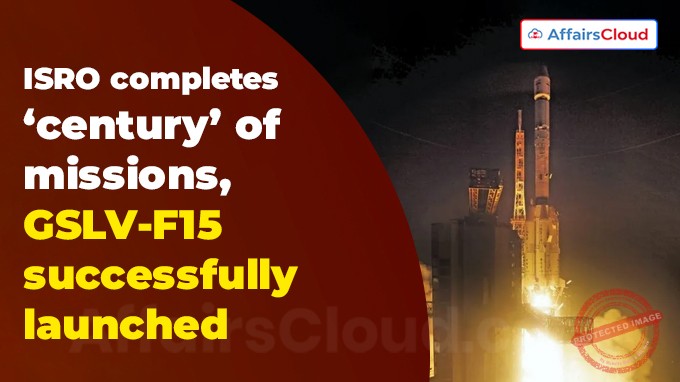 On January 29 2025, the Indian Space Research Organisation (ISRO) successfully launched GSLV-F15/NVS-02 mission, carrying the NVS-02 satellite, from the Second Launched Pad (SLP) Satish Dhawan Space Centre (SDSC) in Sriharikota, Andhra Pradesh (AP). With the successful launch of this mission, ISRO completed its 100th launch from Sriharikota spaceport.
On January 29 2025, the Indian Space Research Organisation (ISRO) successfully launched GSLV-F15/NVS-02 mission, carrying the NVS-02 satellite, from the Second Launched Pad (SLP) Satish Dhawan Space Centre (SDSC) in Sriharikota, Andhra Pradesh (AP). With the successful launch of this mission, ISRO completed its 100th launch from Sriharikota spaceport.
- This mission marks the 17th flight of India’s Geosynchronous Satellite Launch Vehicle (GSLV) and 11th flight with indigenous cryogenic stage.
- It is also the 8th operational flight of GSLV with an indigenous cryogenic stage.
Points to Note:
i.ISRO launched its 1st mission on August 10, 1979, which was the experimental flight of Satellite Launch Vehicle-3 (SLV-3 E10) carrying the Rohini Technology Payload(RTP) from Sriharikota, AP.
ii.Since 1979, ISRO has conducted 99 launches with Polar Satellite Launch Vehicle (PSLV) carrying out 62 launches, followed by GSLV (16), Launch Vehicle Mark-3 (LVM3)(7), Augmented Satellite Launch Vehicle (ASLV) (4), among others.
About GSLV-F15 Rocket:
i.The GSLV-F15 rocket is equipped with an indigenous cryogenic upper stage has successfully placed the NVS-02 satellite into the intended Geosynchronous Transfer Orbit (GTO).
ii.It is a 3-stage launch vehicle, with lift-off mass of 420.7 tonne (t) and height of 50.9 meter (m).
iii.The GSLV-F15 payload fairing is a metallic version with a diameter of 3.4 m.
About NVS-02 satellite:
i.It is 2nd out of the 5 second-generation Navigational Satellite (NVS) series (NVS-01/02/03/04/05), which are designed to augment Navigation with Indian Constellation (NavIC)base layer constellation with improved features for ensuring the continuity of services.
- The NVS series of satellites uses L1 band Standard Positioning Service (SPS) signals to enhance adoption of NavIC services.
- It operates in the L1, L5, and S bands, essential for accurate navigation signals and improved positioning services.
ii.The satellite was designed, developed and integrated at Bengaluru (Karnataka)-based U.R. Rao Satellite Centre (URSC).
iii.It weighs around 2,250 kilogram (kg) and power handling capacity of nearly 3 kilo-Watt (kW) .
iv.It will be placed at 111.75 degree E, and will replace IRNSS-1E, the 5th navigation satellite of the Indian Regional Navigation Satellite System (IRNSS).
Note: In May 2023, ISRO launched GSLV-F12 mission, placed the 1st satellite of the 2nd-generation NVS, NVS-01 into GTO.
About NavIC System:
i.It is previously known as IRNSS, is an independent regional satellite system of India, designed to provide precise Position, Velocity and timing (PVT) service to users in India as well as in regions extending around 1,500 kilometer (km) beyond Indian land mass.
- It will consist of 7 satellites placed in Geosynchronous and inclined geosynchronous orbits.
ii.NavIC will provide two types of services, namely, Standard Positioning Service (SPS) and Restricted Service (RS).
iii.SPS of NavIC will provide a position accuracy of better than 20 m and timing accuracy better than 40 nanoseconds (ns) over the service area.
About Indian Space Research Organisation(ISRO):
It is one of the six largest space agencies in the world.
Chairman- V Narayanan
Headquarters– Bengaluru, Karnataka
Established– 1969




